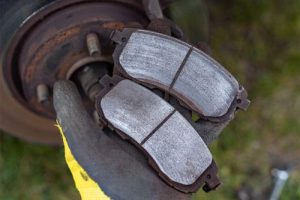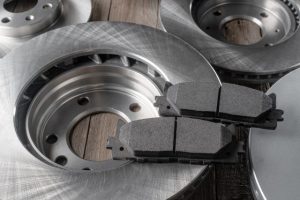Brakes are one of the most vital safety systems in your vehicle, and their efficiency heavily depends on the condition of your brake pads. Ideally, brake pads should wear down evenly on both sides of the car and across each pad’s surface. However, uneven brake pad wear is a common issue that can affect braking performance, increase stopping distances, and lead to more expensive repairs.
In this article, we’ll explain how to spot uneven brake pad wear, what causes it, and what you can do to prevent it.

Common Signs of Uneven Brake Pad Wear
Being proactive about recognizing symptoms can prevent more serious damage. Below are some key warning signs:
| Symptom | Possible Cause |
|---|---|
| Pulling to One Side When Braking | Indicates one wheel has more braking force, often due to uneven pad wear |
| Grinding or Squealing Noise | Often caused by metal contacting the rotor due to worn or uneven pads |
| Vibration When Braking | Uneven surface pressure can cause brake judder or steering wheel vibration |
| Visual Differences Between Pads | Upon inspection, one pad appears much thinner than the other |
| Increased Stopping Distance | Reduced contact area results in lower braking efficiency |
What Causes Uneven Brake Pad Wear?
Understanding the root causes of uneven wear helps ensure your brake system remains effective and safe.
1. Sticking Brake Caliper
When a brake caliper seizes or sticks, it can apply constant pressure to one pad, causing it to wear out much faster than its counterpart.
Symptoms of a sticking caliper:
-
Pulling to one side
-
Excess heat around one wheel
-
Uneven pad thickness
Cause: Corroded caliper pins, damaged piston seals, or debris in the brake assembly.
2. Faulty or Worn-Out Guide Pins
Brake calipers slide on guide pins. If these pins are dry, bent, or rusted, they can restrict caliper movement, causing one side of the pad to wear faster.
| Guide Pin Problem | Resulting Wear |
|---|---|
| Dry or corroded pins | Inner or outer pad wears faster |
| Bent pins | Caliper misalignment, uneven pressure |
| Lack of lubrication | Increased friction, accelerated wear |
3. Improper Brake Pad Installation
Even slight misalignment during pad installation can cause uneven contact with the rotor.
Check for:
-
Pads not sitting flush in the caliper
-
Missing shims or anti-rattle clips
-
Pads installed in reverse (wrong pad on inner/outer side)
4. Warped Rotors
Rotors that are no longer flat can cause intermittent contact with the pad, wearing them unevenly and reducing braking performance.
Causes of warped rotors:
-
Overheating due to aggressive driving
-
Improper torquing of wheel bolts
-
Old or low-quality rotors
5. Unbalanced Brake Force Distribution
A malfunctioning proportioning valve or ABS system may distribute braking force unevenly, especially in front-to-rear or side-to-side configurations.
6. Driving Habits and Conditions
Aggressive braking, driving with heavy loads, or frequent downhill driving can cause faster and more uneven wear.
| Driving Condition | Effect on Pads |
|---|---|
| City traffic / stop-and-go | Uneven pad heating |
| Mountain roads / steep descents | Glazing or rapid wear |
| Towing trailers / heavy loads | Increased stress on rear brakes |
How to Prevent Uneven Brake Pad Wear
Preventive maintenance is key to ensuring even pad wear and optimal braking performance.
Maintenance Checklist:
-
Inspect brake pads every 10,000–15,000 km
-
Lubricate caliper pins with every pad replacement
-
Replace rotors with pads if they’re below minimum thickness
-
Flush brake fluid every 2 years
-
Use quality parts and ensure proper installation
Choose Quality Brake Pads
Not all brake pads are made equal. Low-quality materials can result in premature wear or inconsistent performance. To ensure safety and durability, always choose high-grade pads suited to your vehicle and driving style.
Buy Car Brake Pads online — Explore a wide range of premium OEM and aftermarket brake pads tailored to your vehicle’s specifications.
When to Replace Your Brake Pads

| Condition | Action Required |
|---|---|
| Pad thickness < 3 mm | Replace immediately |
| Uneven wear > 2 mm between pads | Inspect calipers and pins |
| Rotor grooves or scoring | Replace or resurface rotors |
| Constant brake noise | Investigate pad alignment or wear pattern |
Conclusion
Uneven brake pad wear isn’t just a nuisance — it’s a warning sign that something in your braking system needs attention. Ignoring it could lead to compromised safety, longer stopping distances, and more expensive repairs down the road.
Regular inspections, proper installation, and high-quality components can help you avoid this issue altogether. Whether you’re a DIY enthusiast or rely on a trusted mechanic, make brake pad health a top priority in your maintenance schedule.
For reliable replacement parts and expert support, don’t wait —
Buy Car Brake Pads online and ensure your vehicle stops as it should, every time.